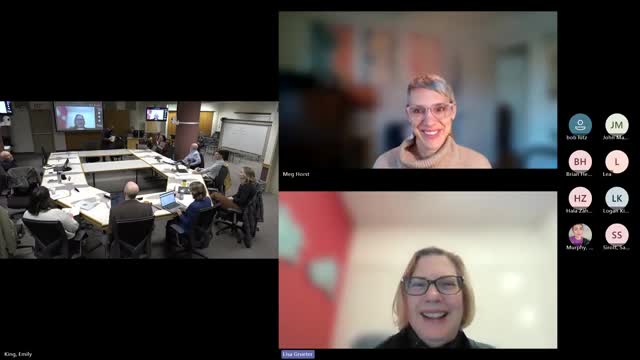Spokane wastewater director: combined-sewer overflows down sharply, membrane treatment cutting phosphorus
January 16, 2025 | Spokane, Spokane County, Washington
This article was created by AI summarizing key points discussed. AI makes mistakes, so for full details and context, please refer to the video of the full meeting. Please report any errors so we can fix them. Report an error »

City wastewater staff told Spokane’s climate advisory board that investments in storage tanks, system controls and a new membrane filtration facility have sharply reduced combined-sewer overflows and improved effluent quality, while urging continued attention to stormwater management and climate-driven event timing.
“I can say proudly that we’re now down to 17,” Raylene (wastewater director) said of the city’s CSO outfalls, and she described a long-term program of tank construction and system upgrades that in recent years produced a single documented overflow event during a heavy November rain. “That 1 overflow did happen with that 1 inch rain,” she said, noting the November event was driven by unusually intense precipitation.
Why it matters: Combined-sewer overflows mix untreated stormwater and sewage and can carry bacteria and pollutants into the Spokane River and downstream waters. The city’s permit-driven obligations and a state TMDL for downstream dissolved oxygen and phosphorus prompted upgrades in treatment and storage; those upgrades matter for public health, aquatic habitat and compliance with state and federal permits.
Body — what the city presented
Raylene walked the board through the CSO program’s history: in the 1970s the city recorded hundreds of annual overflow events and many outfalls; today the city stores excess flows in 29 tanks and protection structures, operates interceptor storage and has reduced annual overflow events dramatically. Raylene said total CSO storage across tanks is about 14 million gallons and the five largest tanks hold nearly 10 million gallons combined.
She described the new membrane filtration facility added to the treatment plant: pilot testing showed the membrane approach achieved higher phosphorus removal than conventional sand filters. In a pilot run the membrane system produced effluent phosphorus concentrations around 0.008 mg/L (8 parts per billion) compared with much higher influent concentrations, a removal rate of approximately 99.8 percent from influent to post-membrane treated water in the samples cited.
Staff emphasized operations and adaptation
Staff said the wastewater system is being actively managed through SCADA and active-control strategies that route flow to the plant when capacity allows and store flow when necessary. City staff and board members discussed green-infrastructure options (swales, Silva Cells, pervious surfaces) and where those measures have succeeded in pilot projects, noting trade-offs in space needs, maintenance and infiltration capacity.
Board members raised related concerns including groundwater contamination and regional water sourcing. Consultant and board discussion during the climate presentation also flagged groundwater/PFAS and Fairchild Air Force Base as local issues to consider when mapping water-resource vulnerability.
Ending — next steps and monitoring
Raylene and staff said the city will continue monitoring overflow frequency and volumes, pursue infiltration and source-control opportunities where feasible, and evaluate long-term treatment or reuse options for biogas and solids. The wastewater presentation was provided to the board as background for future conversations on infrastructure planning within the comprehensive-plan periodic update.
“I can say proudly that we’re now down to 17,” Raylene (wastewater director) said of the city’s CSO outfalls, and she described a long-term program of tank construction and system upgrades that in recent years produced a single documented overflow event during a heavy November rain. “That 1 overflow did happen with that 1 inch rain,” she said, noting the November event was driven by unusually intense precipitation.
Why it matters: Combined-sewer overflows mix untreated stormwater and sewage and can carry bacteria and pollutants into the Spokane River and downstream waters. The city’s permit-driven obligations and a state TMDL for downstream dissolved oxygen and phosphorus prompted upgrades in treatment and storage; those upgrades matter for public health, aquatic habitat and compliance with state and federal permits.
Body — what the city presented
Raylene walked the board through the CSO program’s history: in the 1970s the city recorded hundreds of annual overflow events and many outfalls; today the city stores excess flows in 29 tanks and protection structures, operates interceptor storage and has reduced annual overflow events dramatically. Raylene said total CSO storage across tanks is about 14 million gallons and the five largest tanks hold nearly 10 million gallons combined.
She described the new membrane filtration facility added to the treatment plant: pilot testing showed the membrane approach achieved higher phosphorus removal than conventional sand filters. In a pilot run the membrane system produced effluent phosphorus concentrations around 0.008 mg/L (8 parts per billion) compared with much higher influent concentrations, a removal rate of approximately 99.8 percent from influent to post-membrane treated water in the samples cited.
Staff emphasized operations and adaptation
Staff said the wastewater system is being actively managed through SCADA and active-control strategies that route flow to the plant when capacity allows and store flow when necessary. City staff and board members discussed green-infrastructure options (swales, Silva Cells, pervious surfaces) and where those measures have succeeded in pilot projects, noting trade-offs in space needs, maintenance and infiltration capacity.
Board members raised related concerns including groundwater contamination and regional water sourcing. Consultant and board discussion during the climate presentation also flagged groundwater/PFAS and Fairchild Air Force Base as local issues to consider when mapping water-resource vulnerability.
Ending — next steps and monitoring
Raylene and staff said the city will continue monitoring overflow frequency and volumes, pursue infiltration and source-control opportunities where feasible, and evaluate long-term treatment or reuse options for biogas and solids. The wastewater presentation was provided to the board as background for future conversations on infrastructure planning within the comprehensive-plan periodic update.
View full meeting
This article is based on a recent meeting—watch the full video and explore the complete transcript for deeper insights into the discussion.
View full meeting
